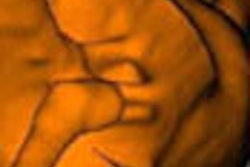Lung nodule features that are suggestive of malignancy in adults may indicate the opposite in children -- and vice versa -- according to a study in the May issue of Radiology.
The study found that misinterpretation led to needless intervention in many children with benign nodules who had been screened with CT for lung cancer because of known primary solid tumors elsewhere. The expert readers' inability to differentiate benign from malignant lesions may be attributed in part to the different appearance of the young patients' metastatic tumors versus primary malignancies, or perhaps to the acquisition of 5-mm-thick sections. But in any case, new methods are needed to separate benign from malignant lung data in children, according to the authors.
"The CT imaging features of pulmonary nodules have been extensively evaluated in adults but not in children," wrote Dr. M. Beth McCarville, Dr. Henrique Lederman, and colleagues from St. Jude's Children's Research Hospital in Memphis, TN, along with investigators from Escola Paulista de Medicina in Sao Paulo, Brazil, and the University of Tennessee in Memphis. "Because children with malignant solid tumors are at risk of pulmonary metastatic disease, they undergo screening chest CT at diagnosis, throughout treatment, and during routine follow-up" (Radiology, May 2006, Vol. 239:2, pp. 514-520).
CT-guided biopsy or thoracotomy is used to direct subsequent management of suspicious nodules, invasive procedures that add to the risks and costs, they wrote.
For their study, the authors determined the incidence of malignancy among 81 pulmonary nodules that were sampled at biopsy within three weeks after chest CT from January 1999 to September 2003 in 41 young patients (mean 13.7 years, range 5-21) with malignant solid tumors. Nineteen (38%) of the 50 patients who had biopsies had multiple nodules sampled.
Between 1999 and 2002, noncontrast imaging was performed on a single-detector scanner (Somatom Plus 4, Siemens Medical Solutions, Malvern, PA) using a collimation of 5 mm for patients younger than 5 and 8 mm for older patients. Images were acquired between February 2002 and September 2003 on an eight-detector LightSpeed Ultra scanner (GE Healthcare, Chalfont St. Giles, U.K.) using a section thickness of 5 mm and a pitch of 1.35:1. All patients were scanned at 120 kVp with mAs adjusted for body weight, and automated exposure control was used on the MDCT scanner, the authors wrote.
Three pediatric radiologists read the lung images independently and retrospectively after being given only the patients' primary diagnoses. Reader 1 had nine years of experience, while readers 2 and 3 had 22 and 24 years of experience, respectively. Examining the current scans and any previous scans, they classified nodules as benign, malignant, or indeterminate based on their number, distribution, size, and margins (indistinct versus distinct), as well as any associated adenopathy. Their results were compared with histological results, and interreader agreement was also assessed.
According to the results, 24 of 41 patients had at least one biopsy-proven malignant nodule. Four of 41 patients (10%) had both malignant and benign nodules, and 17 (42%) had only benign nodules. The three reviewers classified the nodules correctly in 65%, 57%, and 67% of the cases, respectively. All three readers classified a substantial number of nodules (8% to 23%) as indeterminate.
"Because histoplasmosis is endemic in our region, a high percentage of benign nodules in this patient population may be more prevalent," the authors noted.
The small sample size limited the statistical power to detect a significant difference between the incidence of benign and malignant histologic types (95% CI for incidence of benign versus malignant, -0.15-0.68) Interreader agreement was only slight to moderate and was greatest between the two readers whose practices are mostly oncologic.
"All three radiologists were more likely to predict malignancy if nodule margins were sharply defined," the authors wrote. "In adults, however, nodules with sharply defined margins were more often benign, and those with irregular or spiculated margins are usually malignant. We speculate that this difference partly reflects the fact that malignant pulmonary nodules in adults are often primary lung cancers, whereas those in children are almost always metastases. It is also possible that the biologic behavior of primary tumors that metastasize to the lungs differs in those age groups."
They noted that all three readers relied on the presence of sharply defined margins to distinguish benign from malignant nodules, "despite the lack of scientific rationale and despite reports to the contrary in the adult literature."
Moreover, the size and number of nodules in pediatric patients did not predict histologic type, the group noted. In adults, nodules 0.5 cm and smaller are more likely to be benign than malignant.
However the group's results were in accordance with those of Robertson et al, who found that nodules 0.5 mm and smaller "were as likely to be malignant as larger nodules."
The presence of multiple nodules in adults indicate a greater likelihood of malignancy; however, this was not the case in the present study, except for one reviewer who found a greater number of nodules to be marginally associated with malignancy (p = 0.05), the authors wrote.
Finally, stable nodule size over two years is associated with benignity in adults, while in the present study, 29 of 41 nodules with previous scans that allowed comparison did not demonstrate this association. Still, the scans were acquired only a mean of 4.8 months earlier, which may have been too short to establish such an association.
In addition to the limitation of small sample size, six of the benign nodules were shown at histology to be at the site of hemorrhage (n = 2) or normal lung (n = 4). Thus, these may have been false-negative findings due to sampling error.
"Clearly, better methods are needed to discriminate benign from malignant pulmonary nodules in children with malignant solid tumors," the authors wrote. "We have shown that there are important differences between children and adults regarding the CT imaging features of pulmonary nodules."
The group plans to investigate the use of PET/CT for the workup of pulmonary nodules identified at screening.
By Eric Barnes
AuntMinnie.com staff writer
May 16, 2006
Related Reading
Many positive CT scans resolve after short-term follow-up, April 28, 2006
Part I: Automated CT lung nodule assessment advances, April 17, 2006
Familial links may improve patient selection for lung cancer screening, January 2, 2006
Management strategies evolve as CT finds more lung nodules, August 19, 2005
Part I: Imaging the pediatric patient: Beyond the smiles and stickers, April 22, 2004
Copyright © 2006 AuntMinnie.com



















